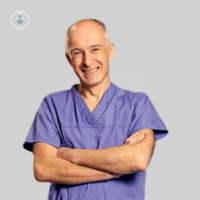Understanding laryngopharyngeal reflux: Symptoms, differences from GERD, and impact on your throat
Written by:In his first article of a two-part series, Professor Martin Anthony Birchall gives us an insight into laryngopharyngeal reflux. He talks about the common symptoms and diagnostic indicators, the key difference between gastroesophageal reflux disease and laryngeal reflux, how does LPR impact the upper respiratory tract and the potential complications.

What are the common symptoms and diagnostic indicators of laryngopharyngeal reflux?
Laryngopharyngeal reflux, often abbreviated as LPR, gained recognition in the 1960s as a prevalent diagnosis for individuals presenting with vague throat complaints. During that era, the medical community's primary objective was to rule out severe conditions like throat cancer. At the time, there was limited understanding of why people experienced these diverse symptoms.
Fast forward to the 1990s, and there was a significant surge in interest surrounding reflux, specifically the phenomenon of stomach acid ascending into the throat and its impact. This issue has now become one of the most commonly diagnosed conditions in the field of ear, nose, and throat (ENT) medicine. When a general practitioner encounters someone with unclear throat symptoms today, the discussion frequently revolves around whether to initiate treatment for reflux, usually involving medications. Despite its prevalence, the precise prevalence of LPR and its effects on the throat remain somewhat elusive. We do, however, recognise that when stomach contents linger in the throat, particularly if they are highly acidic, they have the potential to cause damage. This scenario is more likely to occur during the night when factors like belching, burping, or weak sphincter function at the lower end of the oesophagus can lead to substances staying in the throat for extended periods. During nighttime slumber, swallowing is infrequent, providing an opportunity for these substances to inflict harm. Fortunately, such fluids are typically only mildly acidic, diminishing the likelihood of substantial damage.
Our understanding of LPR is currently undergoing significant evolution, with collaborative efforts between the fields of otolaryngology and gastroenterology. This partnership is shedding light on the role of alterations in gut bacterial flora, which can impact not only the local gastrointestinal tract but also the entire system, potentially affecting factors like mood, energy levels, and overall well-being. As a result, it is essential to stay vigilant and continue exploring the nature of LPR, its origins, and its consequences.
In simpler terms, LPR refers to the chronic presence of acid or stomach contents in the throat, leading to a mixture of symptoms.
What are the key differences between the gastroesophageal reflux disease and the laryngeal reflux in terms of symptoms and management?
There is a significant overlap between classical gastroesophageal reflux disease (GERD) and throat-related symptoms, although it is not a perfect match. They are not entirely synonymous. Classical GERD typically manifests as heartburn, which responds well to interventions like adopting a low-acid diet and taking medications such as proton pump inhibitors or alginates. These medications can soothe the effects of stomach acid. Diagnosis often involves an endoscopy performed by a gastroenterologist or a surgeon who specialises in upper gastrointestinal issues. The management of classic GERD is well-established, including surgical options.
However, understanding and addressing laryngopharyngeal reflux (LPR) present greater challenges. LPR symptoms may include hoarseness, chronic cough, the sensation of a lump or tightness in the throat, an acidic or metallic taste in the throat, frequent throat clearing, and sometimes persistent throat discomfort. LPR differs from classical GERD in that it involves acid not only affecting the oesophagus but also ascending and affecting the throat.
In summary, while there is a significant overlap between GERD and throat symptoms, they are not identical conditions. Classic GERD is more straightforward to manage with well-defined treatments, including surgery when necessary. On the other hand, LPR poses a more complex diagnostic and treatment challenge due to its unique set of symptoms and the involvement of the throat.
How does LPR impact the upper respiratory tract and what are the potential complications associated with this condition?
When stomach acid or its contents reach the upper part of the throat, it can lead to significant harm. It's widely recognised that these substances can erode the back of the teeth. However, the vocal cords and the surrounding area are especially susceptible tissues. Unlike the stomach, these tissues lack the natural defences against acid. Consequently, even minimal exposure can result in long-term, low-intensity burning, scarring, and inflammation. These effects are responsible for the emergence of other symptoms such as chronic cough, the sensation of a lump in the throat, and changes in voice quality.
Professor Martin Anthony Birchall is an esteemed ENT specialist with over 35 years of experience. You can book an appointment with Professor Birchall on his Top Doctors profile.


